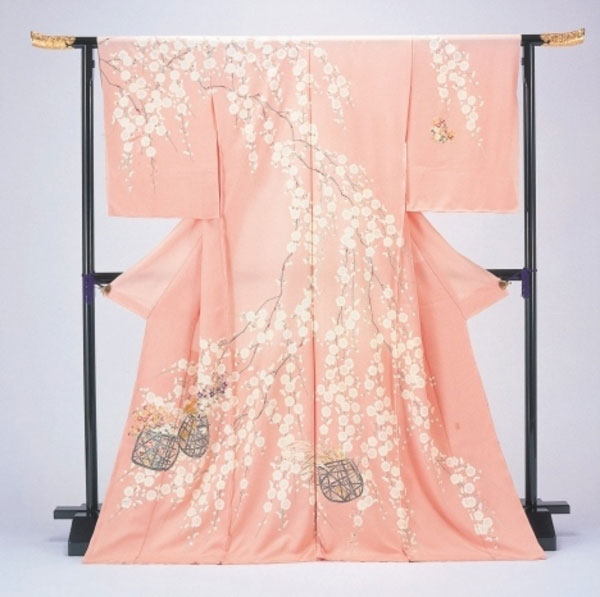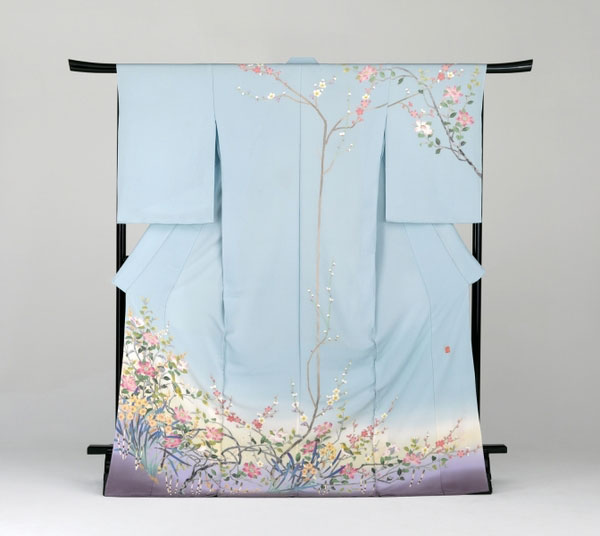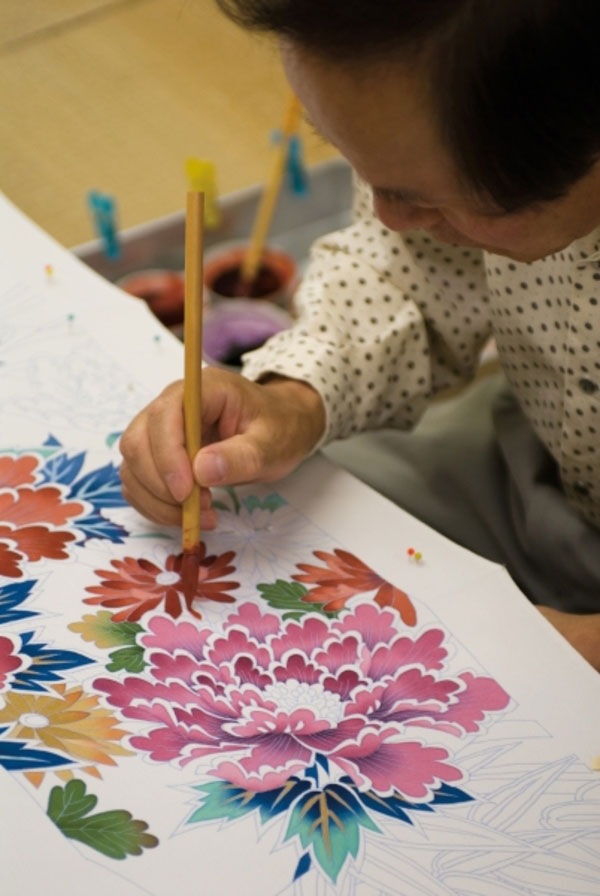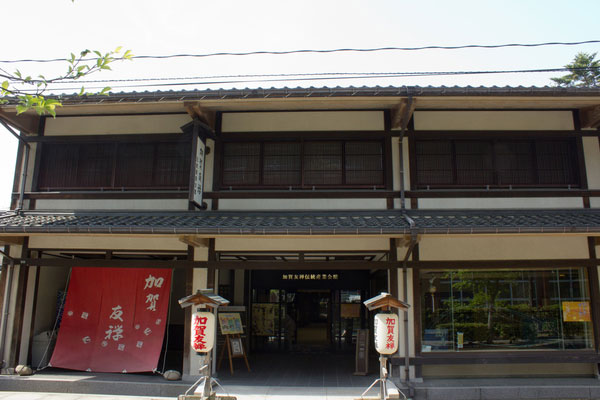 Photo:Ishikawa Prefecture Tourism League
Photo:Ishikawa Prefecture Tourism League
- Dyed textiles
- Ishikawa
Kaga textiles Kaga yuzen
Delicate patterns reflecting the beauty of nature
Vivid refined colors - Exceptional craftsmanship
Description
What is Kaga textiles ?
Kaga textiles (called Kaga yuzen in Japanese) are kimonos produced around the city of Kanazawa, Ishikawa prefecture. This craft is noteworthy because of its use of five underlying tones: indigo, khaki, green, dark reddish purple, and deep red. Kyoto and Kaga textiles are often compared, however they are different because Kyoto textiles has design patterns with gold leaves and embroidery while Kaga textiles features classical deep tones centering on reddish colors and floral print designs, representing the natural beauty of Kanazawa. The craft's delicate patterns are enhanced by the distinctive gradation from the edges to the center of each motif or a design that depicts mushi-kui (worm eaten), or dying leaves, adding realism. The itome nori dyeing technique is another important feature of the craft, involving creating patterns with dye resistant glue to draw designs which will be washed out after dyeing. This creates beautiful white borders that enhance the effect of the whole design. Kaga textile was named after the founder of its dyeing technique, Yuzensai MIYAZAKI (1688-1703) who began yuzen dyeing in Kyoto and spent his final years in Kanazawa. Kaga textiles techniques rapidly developed under his mentorship and the patronage of the wealthy Kaga domain. Today, Kaga textiles has a subtle samurai style because historically it was developed within the incredibly wealthy samurai culture of Kaga, which had a yield harvest of one million koku (traditional unit of volume) of rice.
History
 Photo: Ishikawa Prefecture Tourism League
Photo: Ishikawa Prefecture Tourism League
Kaga was originally a production region of silk and hemp as it was blessed with several rivers and waterways that could supply the copious amounts of water required for the washing process of yuzen dyeing. Scholars believe that ume zome is the origin of Kaga textile dyeing method dating back to around the mid-15th century. Other dyeing techniques such as kenbo zome, iro e, and iro-e-mon have also been handed down for generations in Kaga. Around the mid-17th century, all the dyeing techniques were gathered together and these techniques were established as the "Kaga no okunizome techniques". Then in the mid-Edo period (1603-1868), Yuzensai MIYAZAKI from Kyoto learned the techniques as a basis of his craft and established the current Kaga textiles craft. Kaga textiles flourished under the patronage of the Kaga domain and over time each dyeing technique became increasingly specialized. This rich opulent fabric tradition was carried into the modern period, but experienced a serious setback due to restrictive laws on luxury goods imposed before and after World War II. However production flourished once more after the 300th anniversary of Yuzensai MIYAZAKI's establishment. The development continued with further technical advances and the establishment of the Kaga Textile Dyeing Complex Cooperative, and Kaga textiles was registered as a National Traditional Craft by the Ministry of Economy, Trade and Industry in 1975. Although quicker methods of producing designs like machinery are valued today, the Kaga textile process continues to use traditional handwork with many artists and craftsmen still upholding the traditional techniques and skills. Those traditions are kept to produce these stunningly beautiful fabric artworks.
Production Process
 Photo: Ishikawa Prefecture Tourism League
Photo: Ishikawa Prefecture Tourism League
- 1. The design Artisans use the tradition of Kaga textile to design new patterns and motifs. This process is one of the most painstaking ones for the artisans because it requires the design of picturesque patterns and colors to capture the beauty of the nature of Kanazawa while also imaging the wearer, the wearer's age, and the final look of a piece.
- 2. Basting Undyed fabrics are cut into kimono sections such as the sleeves, collar, and body, ready to baste, or make quick, temporary stitching intended to be removed. Fabrics are high quality silks such as silk crepe from Kyoto, hard twine yarn silk from the city of Nagahama, Shiga prefecture, and silk from Ishikawa prefecture.
- 3. Rough sketching Rough sketches are placed on a glass covered table with lighting from the underside. The basted undyed fabric is laid on top and the sketches are transferred to the fabric in fine lines with a brush. Another technique is to draw rough sketches directly on undyed fabric using aobana (dayflower sap) which disappears after washing during a later step. Artisans resolutely uphold tradition and stick to hand drawing even though it is a complex and time consuming procedure.
- 4. Masking with resist paste Using a special cylindrical tool, outlines of the rough sketch are drawn with a type of resist paste made from rice called itome-nori. The paste prevents the colors from mixing or spreading when dyeing.
- 5. Undercoating A coat of watery soybean broth (gojiru) or diluted glue made of seaweed, funori, is applied to the reverse side of the fabrics, which are then dried over a fire. During this step, aobana, dayflower sap that was used to draw a rough sketch, is washed away, and the itome nori or resist paste is more firmly attached to the fabric.
- 6. Coloring A variety of dyes based on the traditional five colors of Kaga textiles (called Kaga gosai): indigo, khaki, green, dark reddish purple, and deep red, are used to color the designs and motifs. The artisan uses a paint brush and a small flat brush to apply colors before steaming the fabric to fix the colors and prevent the dyes from soaking into the paste in the next step called nakaume.
- 7. Pasting In preparation for the next process jizome or texture dyeing, a paste made from glutinous rice is applied on the patterns. This is to prevent the ground colors from seeping into the newly painted areas and to keep the colors fresh and vibrant.
- 8. Base colors The base color of the kimono is applied to unpainted areas with a large flat brush. Spreading the base colors evenly requires high skill and many years of experience.
- 9. Steaming Once the base colors have dried, fabrics are placed in a steaming box to swell the fibers and allow the dye to thoroughly permeate and fix the color in the fabric.
- 10. Washing Traditionally, finished fabrics were washed in natural flowing river water to remove the paste and excess dye. This process was famous as a signature event of Kanazawa called yuzen nagashi or yuzen washing. Today, washing mostly takes place in artificial watercourses located in the dyeing complex.
- 11. Finishing touches After the fabric is washed, it is dried, steamed, finishing touches are added with pigments etc., and the colors are finely tuned. This time-honored production process is still handmade with traditional methods by artisans and so every detail of the colors, lines, and shapes are deeply imbued with their passion.
Facility Information
Kaga-Yuzen Dento Sangyo Kaikan

-
Address
-
Tel.+81-76-224-5511
-
ClosedWednesdays (open if it is a holiday), around the New Year
-
Business Hours9am to 5pm
-
Website
Related Artists
- You will be redirected to the artist's page on the Gallery Japan website
Other Dyed textiles
- Kaga textiles
- Kyo textiles
- Tokyo fine-patterned dyeing
- Nagoya textiles
- Kyo-komon textiles
- Arimatsu tie-dyeing
- Ryukyu traditional textiles
- Tokyo textiles
- Kyo dyed textiles
- Nagoya kimono-dyeing
- Kyo kimono-dyeing
- Naniwa Honzome Hand Dyeing
- Tokyo Honzome Chusen
- Tokyo Plain Dyeing































































































































































































































































































